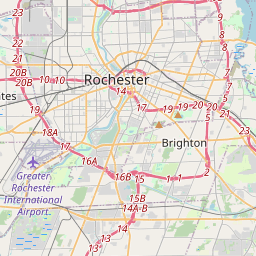Original Site of Frederick Douglass Monument
Historical marker location:
Rochester, New York
( Marker is at the intersection of Saint Paul Street and Central Avenue, on the right when traveling north on Saint Paul Street.)
Marker installed: 1999






© OpenStreetMap contributors
Loading...
Searching for other points of interest within 3 miles of this location.The New York City subway system, which opened in 1904, was the first rapid transit system in the world. The original line ran from City Hall to 145th Street in Harlem.
About Monroe County
Monroe County Timeline
Monroe County, located in western New York state, has a rich and diverse history that dates back thousands of years. The area was originally inhabited by indigenous Native American tribes, including the Seneca and the Tonawanda Seneca Nations. These tribes thrived in the region, relying on the abundant resources provided by the Genesee River and the surrounding land.
In the late 18th century, European settlers began to arrive in the area, attracted by the fertile soil and the potential for trade along the river. In 1808, Monroe County was officially established and named after President James Monroe. The early years were marked by agricultural development, with farms and mills being established across the county.
The construction of the Erie Canal in the early 19th century had a significant impact on Monroe County. The canal connected the Great Lakes with the Hudson River, making Rochester, the county seat, a bustling center of commerce and industry. Businesses flourished as the city became a major transportation hub, attracting entrepreneurs and immigrants from all over the world.
Throughout the 20th century, Monroe County continued to develop and diversify. Rochester became known as the "Flower City," with flourishing horticulture and seed industries. The county also played a vital role in the manufacturing sector, particularly in the production of cameras, optical equipment, and other technological advancements.
Today, Monroe County remains a vibrant and thriving region, with a strong economy and a rich cultural heritage. The county is home to numerous educational institutions, including the University of Rochester and the Rochester Institute of Technology, solidifying its reputation as a center for innovation and knowledge. While industry has evolved and changed over the years, the county continues to adapt and thrive in a rapidly changing world.
In the late 18th century, European settlers began to arrive in the area, attracted by the fertile soil and the potential for trade along the river. In 1808, Monroe County was officially established and named after President James Monroe. The early years were marked by agricultural development, with farms and mills being established across the county.
The construction of the Erie Canal in the early 19th century had a significant impact on Monroe County. The canal connected the Great Lakes with the Hudson River, making Rochester, the county seat, a bustling center of commerce and industry. Businesses flourished as the city became a major transportation hub, attracting entrepreneurs and immigrants from all over the world.
Throughout the 20th century, Monroe County continued to develop and diversify. Rochester became known as the "Flower City," with flourishing horticulture and seed industries. The county also played a vital role in the manufacturing sector, particularly in the production of cameras, optical equipment, and other technological advancements.
Today, Monroe County remains a vibrant and thriving region, with a strong economy and a rich cultural heritage. The county is home to numerous educational institutions, including the University of Rochester and the Rochester Institute of Technology, solidifying its reputation as a center for innovation and knowledge. While industry has evolved and changed over the years, the county continues to adapt and thrive in a rapidly changing world.
Monroe County Timeline
This timeline provides a glimpse into the major events and milestones that have shaped the history of Monroe County, New York.
- 1683 - Monroe County is part of Albany County, which was formed by the English colonial government.
- 1796 - The Treaty of Big Tree is signed, transferring land in Monroe County from the Seneca Nation to the United States.
- 1812 - Haussauer's Mills, now known as Rochester, is settled by European-American settlers on the Genesee River.
- 1821 - Monroe County is officially created as a county from parts of Genesee County and Ontario County.
- 1823 - Rochester becomes the county seat of Monroe County.
- 1834 - Nathaniel Rochester, one of Rochester's founders, dies. The city is named after him.
- 1842 - The Erie Canal is enlarged and deepened, boosting Rochester's economy and population.
- 1853 - Rochester becomes an incorporated city.
- 1905 - The City of Rochester annexes several surrounding towns and villages, expanding its borders.
- 1950s - Kodak and Xerox, both headquartered in Rochester, have their heyday and contribute to the local economy.
- 2017 - Unity Health System and Rochester General Health System merge to form Rochester Regional Health, a major healthcare provider in the area.